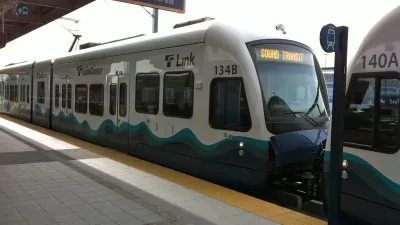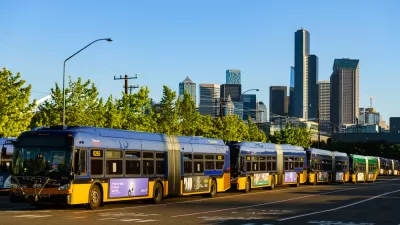The Seattle Transportation Benefit District has led to a growth in ridership and improved access to frequent service, according to a third-year performance report.

Stephen Fesler looks at outcomes of the Seattle Transportation Benefit District as it finishes up its third year. Funding for the STBD came from a 2014 measure approved by voters to expand transit services through a $60 vehicle license fee and a 0.1 percent sales tax increase. The STBD has provided a good return on investment, with $0.91 for every dollar going directly to improving transit services and access.
Since 2015, transit ridership has increased in Seattle on all modes, and much of this growth has happened on regional partnership bus routes. Access also improved between 2015 and 2018. In 2018, over two-thirds of households were within a 10-minute walk of transit service with a frequency of at least 10 minutes, up from a quarter of households in 2015.
In addition, notes Fesler, on-time performance of buses in Seattle improved, the ORCA Youth Card program grew, and more bus routes were added to a service to hiking trailheads.
Funding for the STBD will end next year without reauthorization. In addition to the annual spending on service and access improvements, the Seattle Department of Transportation can spend an additional $10 million on capital projects through the end of 2020. "These investments could include transit-only lanes, queue jumps, transit signal priority, and other strategies to improve speed and reliability," says Fesler.
FULL STORY: Looking Back on Three Years of Transit Investment in Seattle

Planetizen Federal Action Tracker
A weekly monitor of how Trump’s orders and actions are impacting planners and planning in America.

San Francisco's School District Spent $105M To Build Affordable Housing for Teachers — And That's Just the Beginning
SFUSD joins a growing list of school districts using their land holdings to address housing affordability challenges faced by their own employees.

The Tiny, Adorable $7,000 Car Turning Japan Onto EVs
The single seat Mibot charges from a regular plug as quickly as an iPad, and is about half the price of an average EV.

Seattle's Plan for Adopting Driverless Cars
Equity, safety, accessibility and affordability are front of mind as the city prepares for robotaxis and other autonomous vehicles.

As Trump Phases Out FEMA, Is It Time to Flee the Floodplains?
With less federal funding available for disaster relief efforts, the need to relocate at-risk communities is more urgent than ever.

With Protected Lanes, 460% More People Commute by Bike
For those needing more ammo, more data proving what we already knew is here.
Urban Design for Planners 1: Software Tools
This six-course series explores essential urban design concepts using open source software and equips planners with the tools they need to participate fully in the urban design process.
Planning for Universal Design
Learn the tools for implementing Universal Design in planning regulations.
Smith Gee Studio
City of Charlotte
City of Camden Redevelopment Agency
City of Astoria
Transportation Research & Education Center (TREC) at Portland State University
US High Speed Rail Association
City of Camden Redevelopment Agency
Municipality of Princeton (NJ)





























